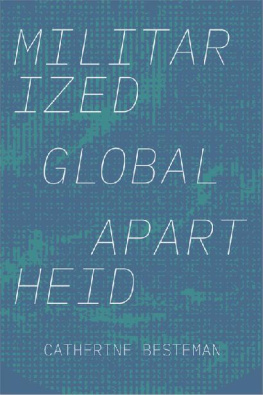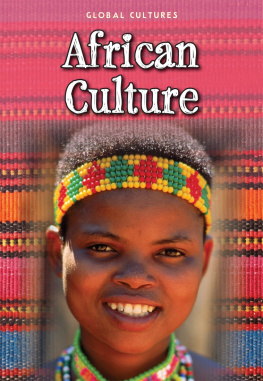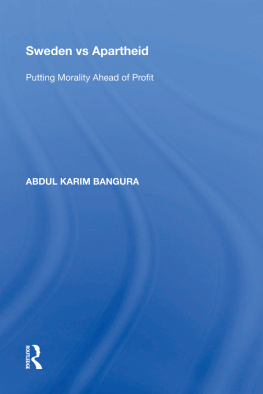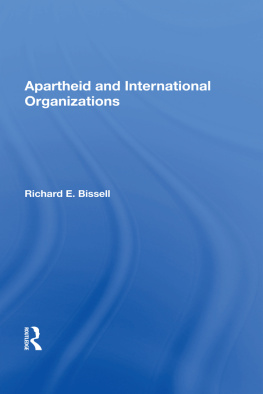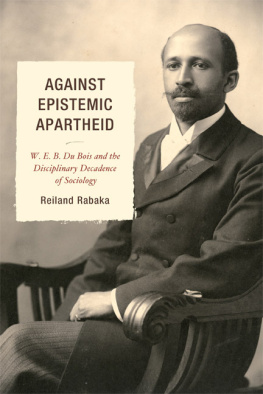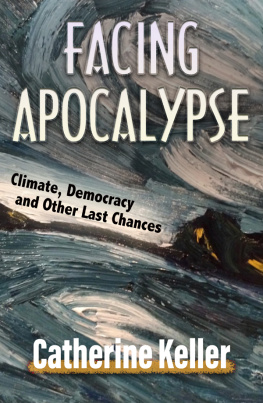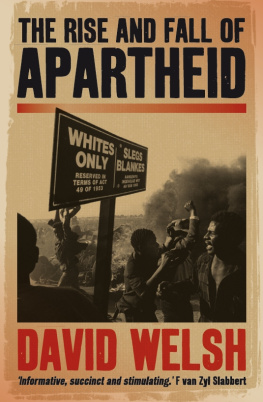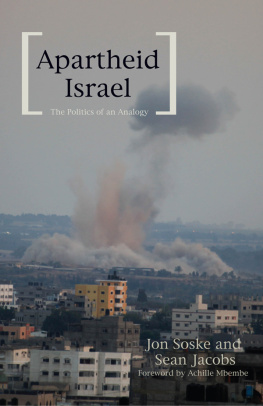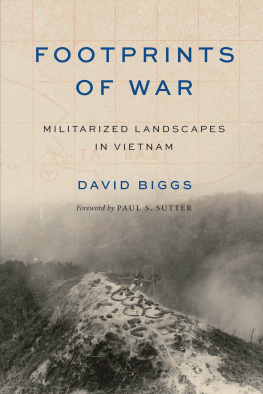GLOBAL INSECURITIES
A SERIES EDITED BY CATHERINE BESTEMAN AND DARRYL LI
MILITARIZED
GLOBAL
APARTHEID
CATHERINE BESTEMAN
Duke University Press
Durham and London 2020
2020 DUKE UNIVERSITY PRESS
ALL RIGHTS RESERVED
PRINTED IN THE UNITED STATES OF AMERICA ON ACID FREE PAPER
DESIGNED BY AIMEE C. HARRISON
TYPESET IN MINION PRO AND IBM PLEX MONO
BY WESTCHESTER PUBLISHING SERVICES
Library of Congress Cataloging-in-Publication Data
NAMES: BESTEMAN, CATHERINE LOWE, AUTHOR.
TITLE: MILITARIZED GLOBAL APARTHEID / CATHERINE BESTEMAN.
OTHER TITLES: GLOBAL INSECURITIES.
DESCRIPTION: DURHAM : DUKE UNIVERSITY PRESS, 2020. | SERIES: GLOBAL INSECURITIES | INCLUDES BIBLIOGRAPHICAL REFERENCES AND INDEX.
IDENTIFIERS: LCCN 2020017122 (PRINT) | LCCN 2020017123 (EBOOK)
ISBN 9781478010432 (HARDCOVER)
ISBN 9781478011507 (PAPERBACK)
ISBN 9781478013006 (EBOOK)
SUBJECTS: LCSH: EMIGRATION AND IMMIGRATIONECONOMIC ASPECTS. | DEVELOPED COUNTRIESEMIGRATION AND IMMIGRATIONGOVERNMENT POLICY. | DEVELOPED COUNTRIESEMIGRATION AND IMMIGRATION. | DEVELOPING COUNTRIESEMIGRATION AND IMMIGRATION.
CLASSIFICATION: LCC JV6038 .B478 2020 (PRINT) | LCC JV6038 (EBOOK) | DDC 331.6/21724DC23
LC RECORD AVAILABLE AT HTTPS://LCCN.LOC.GOV/2020017122
LC EBOOK RECORD AVAILABLE AT HTTPS://LCCN.LOC.GOV/2020017123
In recognition that our contributions are vastly different in scale, size, and scope, I note that this modest book is inspired by and indebted to Cedric Robinsons reflection on his masterful Black Marxism :
AS A SCHOLAR IT WAS NEVER MY PURPOSE TO EXHAUST THE SUBJECT, ONLY TO SUGGEST THAT IT WAS THERE.
Cedric Robinson, Black Marxism: The Making of the Black Radical Tradition , xxxii
CONTENTS
On Tuesday, April 21, 2015, three major stories in the New York Times included an article about the disastrous loss of over eight hundred lives in the Mediterranean when a ship filled with hopeful migrants sank on April 18, an article about the arrest of six young Somali Americans in Minnesota who were suspected of attempting to join ISIS , and an article about the hundreds of thousands of missing black men across the country who are in prison. These seemingly disparate stories about normal topics of the day in 2015the upsurge in the number of refugees attempting to reach Europe, security fears about immigrants, and the disproportionate incarceration of Black men in the United Statesreflect an emergent new world order in which race and mobility feature as primary variables for which heightened security and militarization are the answer. This book attempts to sketch out some dimensions of this new world order, a militarized form of global apartheid.
Militarized global apartheid is a loosely integrated effort by countries in the global north to protect themselves against the mobility of people from the global south. The new apartheid apparatus takes the form of militarized border technologies and personnel, interdictions at sea, biometric tracking of the mobile, detention centers, holding facilities, and the criminalization of mobility. It extends deep into many places from which people are attempting to leave and pushes them back; it tracks them to interrupt their mobility, stops them at certain borders for detention and deportation, pushes them into the most dangerous travel routes, and creates new forms of criminality. It stretches across most of the globe, depends on an immense investment of capital, and feeds a new global security-industrial complex. It draws on and remakes historically sedimented racial formations that are highly localized but articulated with global imaginaries of race and racial difference. Because the new apartheid relies on and nurtures xenophobic ideologies and racialized worldviews, it recasts the terms of sovereignty, citizenship, community, belonging, justice, refuge, and civil rights and requires the few who benefit to collectively and knowingly demonize and ostracize the many who are harmed. It is at its most visibly militarized in Israel, and also in Australia, Europe, and the United States, where it serves the purpose of guarding hegemonic whiteness.
A new form of imperialismsecurity imperialismis emerging from and shoring up global militarized apartheid. Security imperialism is expressed in the policies and practices used to identify and contain risky people throughout the globe, accompanied by interventions to securitize space for militaristic and economic domination. These emergent imperial formations are spatial and technological rather than territorial, and they are taking shape through projects that racialize and incarcerate people while securing cosmopolitan class privilege and capitalist extraction across borders. They tether the concept of security to militarization and make the militarization of everyday life normal.
ON VOCABULARY
Throughout this book I use the global north to mean the U.S., Canada, Europe, Israel, Australia, New Zealand, Russia, the Gulf Cooperation Council countries (United Arab Emirates, Bahrain, Saudi Arabia, Oman, Qatar, Kuwait), and East Asia (Japan, South Korea, Singapore, China, Hong Kong, and Taiwan). This list overlaps considerably with the group of states identified by political scientist and Pentagon consultant Thomas Barnett as the Functioning Core interconnected through globalization (which he defines as network connectivity, financial transactions, liberal media flows, and connective security) in his influential The Pentagons New Map. Barnett argues that the Functioning Core should initiate U.S.-led military occupations in the areas he identifies as The Non-Integrating Gap, places he identifies as existing outside of globalization and that constitute the greatest security threats in the world today: the Caribbean rim, virtually all of Africa, the Balkans, the Caucasus, Central Asia, the Middle East and Southwest Asia, and much of Southeast Asia, in addition to Central America and most of the countries in South America. Of additional concern to Barnett are the places he identifies as Seam StatesMexico, Brazil, South Africa, Morocco, Algeria, Greece, Turkey, Pakistan, Thailand, Malaysia, the Philippines, and Indonesiathat buffer the Non-Integrating Gap from the Functioning Core. He promotes a strong U.S. military presence in the Seam States as a strategy to control mobility and secure the Functioning Core against terrorism. I lead with Barnetts argument not because of his influence in anthropologyhe has none, so far as I can tellbut because his model is a potent expression and extension of the homeland security doctrine that has redefined U.S. militarism, militarization, and policing since 9/11 and reshaped security regimes and security empires across the world as part of the global war on terror.
With some exceptions, Barnetts Non-Integrating Gap and Seam States roughly correspond to the global south of this book. But, as will become clear, I do not accept his reasoning about their similarities or why they should be grouped together for heuristic analytical purposes. In their book about why the global south is a harbinger of political futures in the global north, Jean and John Comaroff define the global south as a polythetic category, its members sharing one or morebut not all, nor even mostof a diverse set of features. The closest thing to a common denominator among them is that many were once colonies, protectorates, or overseas possessions, albeit not necessarily during the same epochs. Following the Comaroffs, my use of the generalizing phrase global south is not meant to imply unity or homogeneity, orcentral to my argumentthat the global south is in any way disarticulated from the global north. It is also not meant to overlook class divisions that pervade the global south as well as the global north, including the presence across the global south of global cities and the existence of a global class of cosmopolitan elites who share the control of wealth, capitalist interests, access to political power, and the ability to move freely. (Of particular interest is China, which is one of the worlds largest exporters of migrants, with a massive internal migration system of its own, as well as a rising status as a premier global financial lender and capitalist investor, with, some argue, imperialist designs.) Nevertheless, also central to my argument is the claim that it is possible to theorize in general terms an emerging militarized, hierarchical relationship governing the management of migration and labor mobility from those countries I identify as the global south to those countries I identify as the global north, and that this relationship has historical antecedents.

